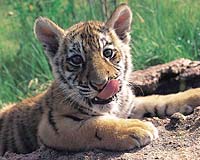| . |  |
. |
Soysambu Conservancy, Kenya (AFP) Feb 10, 2010 Kenyan game rangers on Wednesday began rounding up thousands of zebras to be moved to a reserve where starving lions have been attacking livestock. The spectacular nationwide operation, launched in Soysambu conservancy by the Kenyan Wildlife Service (KWS), is due to last until the end of the month in what will go down as one of Africa's largest animal translocations yet. Shortly after daybreak, rangers in helicopters rounded up startled galloping zebras into a large V-shaped tarpaulin enclosure. The animals at the narrow end of the enclosure were allowed through into an adjoining pen and from there they were loaded on to trucks, each carrying some two dozen zebras. KWS aims to move some 7,000 animals in all, 4,000 zebra and 3,000 wildebeest. At least 88 zebras had been captured Wednesday, hours into the operation. Around 1,000 animals will come from Soysambu, near the Rift Valley city of Nakuru, a private conservancy owned by Delamere Estates. The remainder will be taken from several other reserves. The operation, costing 103 million shillings (1.3 million dollars), will be carried out in four phases and run to February 28, KWS officials said. The plan is to restock Amboseli, some 300 kilometres (185 miles) from Soysambu, with natural prey so as to prevent hyenas and lions from attacking livestock in homes around the park. "Some herders lost as high as 80 percent of their stock due to the drought and the few that were remaining were attacked by hyenas and lions and that angered the local community," KWS spokesman Paul Udoto told AFP. "One of the quick remedies is for KWS to restock the park. It is one way of restoring the balance between carnivores and herbivores in the park as well as reducing the lion and hyena attacks on livestock," he said. Charles Musyoki, a scientist with KWS explained that Amboseli park is a "dry season feeding refuge for herbivores" where animals jostle around water holes and patches of pasture then leave when rainfall resumes in the regions they migrated from. But last year the animals did not move out of the park because of the prolonged dry spell, and many died. "We lost significant numbers of wildebeests and zebras. Over 60 percent of zebras and wildebeests were lost in that ecosystem," Musyoki said. "The deaths created an imbalance in the number of carnivores and herbivores in the park resulting in a shortage of the lions' and hyenas' normal food," spokesman Udoto said. As a result the predators turned to preying on domestic animals. "It is expected that the restocking will restore the balance of animals within the park and reduce the lion and hyena attacks on livestock," Udoto said. In August, KWS said Kenya was losing 100 lions each year as cattle herders killed them in retaliation for attacks on their stock. But habitat destruction, disease and the rising human population also played a role in the population fall from 2,749 animals seven years ago to 2,000 today. Last year's drought was one of the worst in years across eastern Africa. Kenya's last massive animal transfer was in 2005, taking 400 elephants from an over-crowded coastal reserve to a vast inland park, but that had to be halted due to drought which threatened their survival in their new home. At the time is was dubbed "the single largest translocation of animals ever undertaken since Noah's Ark." Wildlife is one of Kenya's main tourist attractions while tourism -- the country's top foreign currency earner -- is still recovering from the ravages of the violence that broke out following the disputed December 2007 elections.
Share This Article With Planet Earth
Related Links Darwin Today At TerraDaily.com
 Not just China - US under fire for tiger trade
Not just China - US under fire for tiger tradeWashington (AFP) Feb 10, 2010 Conservationists appealed Wednesday for an end to the commercial tiger trade, warning that demand in China, Southeast Asia - but also the United States - was threatening the big cats with extinction. Environmental campaigners see 2010 as crucial to spread their message as East Asian nations celebrate the Year of the Tiger and Russia prepares to hold a summit on tiger conservation in Septem ... read more |
|
| The content herein, unless otherwise known to be public domain, are Copyright 1995-2010 - SpaceDaily. AFP and UPI Wire Stories are copyright Agence France-Presse and United Press International. ESA Portal Reports are copyright European Space Agency. All NASA sourced material is public domain. Additional copyrights may apply in whole or part to other bona fide parties. Advertising does not imply endorsement,agreement or approval of any opinions, statements or information provided by SpaceDaily on any Web page published or hosted by SpaceDaily. Privacy Statement |